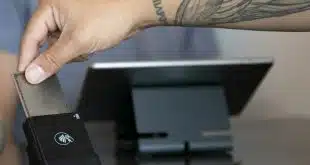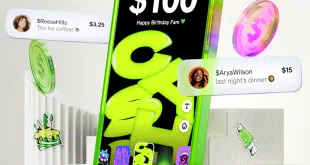Suddenly, person-to-person payments services are gaining utility beyond just paying a person via a smart phone. What gives?
So you thought these newfangled person-to-person payment services were meant only to replace cash with smart-phone apps that enable individuals to send and receive money electronically? Think again.
All of a sudden, some P2P services are positioning themselves as payment alternatives for merchants. That’s good news for companies like PayPal Holdings Inc., which finally may have found a profitable use for its popular but revenue-starved Venmo app.
It’s also good news for Apple Inc. and its brand-new Apple Pay Cash service. Yes, Apple Pay Cash is primarily meant for individuals to pay each other on Apple mobile devices such as the iPhone, but it also can be used wherever the 3-year-old Apple Pay mobile-payment service is accepted.
That’s really good news for Discover Financial Services, which is providing the network that will connect merchants to the Apple Pay Cash system. If consumers see Apple Pay Cash as a good way to buy things, Discover’s transaction volume will rise.
If you’re interested in cryptocurrencies, perhaps you’re one of the lucky test subjects who can use the Square Cash P2P service from Square Inc.—whose primary business is merchant acquiring and software services for businesses—to buy or sell Bitcoin.
Then there’s Mastercard Inc. and its new Mastercard Cash Pick-Up service, which combines corporate disbursements with P2P. The recipient’s money isn’t electronically stored somewhere. It’s spit out by an ATM as old-fashioned cash.
Monetizing Venmo
Jordan McKee, principal analyst, payments, at 451 Research LLC’s Boston office, is watching all the P2P developments with satisfaction.
“It’s an incredibly dynamic space at the moment, and it’s fun to watch as the services evolve,” he says.
McKee believes the services will need to keep on changing lest they lose customers who want more than a one-trick payments pony.
“It’s going to be very unlikely that a consumer will continue to use an app that only sends money back and forth over time,” McKee says. “The providers are starting to realize they need to evolve the value proposition.”
Online P2P services, later supplemented by mobile iterations, have been around for about a decade, but the majority of consumers still haven’t tried them, according to a recent 451 Research survey. And no one has yet found a way to get consumers to pay for them, which in part explains the rush of new features.
PayPal clearly was hoping to generate a new revenue stream from merchants when chief executive Dan Schulman declared during the company’s third-quarter earnings call in October that PayPal would begin “to monetize Venmo.”
Venmo generated $9.4 billion in payment volume in the third quarter, up 93% in a year. The service, however, charges no fees for sending funds from a Venmo balance, bank account, or debit or prepaid card. The only fee is 3% if funds come from a credit card, so, for all its popularity with consumers, Venmo contributes little to PayPal’s top line.
The first step in the monetization movement took place earlier in October with an announcement that as many as 2 million PayPal-accepting merchants were eligible to accept Venmo online and in-app. PayPal will collect the same merchant fees on these transactions as it does for regular PayPal payments. Those fees start at 2.9% plus 30 cents and decline with volume.
‘A Huge Win for Discover’
Meanwhile, Apple is positioning the new Apple Pay Cash as an easy-to-use P2P service through its Messages app that sends and receives text messages. The app gives Apple Pay Cash a social-networking overlay similar to that of Venmo.
Within Messages, users can send, receive, or request funds. The service also works with Apple Watch, and users can give instructions to Siri, Apple’s artificial-intelligence exemplar, to issue funds.
Senders tap a digital-only Apple Pay Cash Card for the money, and may also rely on other cards stored in their Apple Pay wallet if sufficient funds aren’t available on the Cash Card. The card is a prepaid product managed by Pasadena, Calif.-based prepaid card services provider Green Dot Corp. and its Green Dot Bank.
Recipients need an Apple Pay Cash Card to access funds. They can use the money instantly, unless a security check is needed, to pay someone or make purchases using Apple Pay in stores, apps, and on the Web, according to Apple. They also can transfer funds from Apple Pay Cash to their bank account.
While personal payments are the main market Apple is targeting, the Apple Pay Cash Card can be used for payments at any merchant that accepts Apple Pay, which relies on contactless near-field communication technology. Apple said in November that 5 million U.S. retail locations would be accepting Apple Pay at the end of 2017, and that 67 of the top 100 U.S. retailers now take it.
Though the three so-called general-purpose “Pays”—Apple Pay, Alphabet Inc.’s Android Pay, and Samsung Electronics Co. Ltd.’s Samsung Pay—lag far behind PayPal in mobile volume, Apple Pay has been getting more usage than its two main competitors.
Apple, without giving numbers, said Apple Pay users doubled over the past year and that transaction volume rose 330%. And now, Apple Pay Cash is poised to give the mother service a lift, though nobody knows yet how big that lift might be.
After all, why use an Apple Pay Cash Card rather than an account the consumer has in her Wallet to fund conventional Apple Pay transactions?
“I’m not entirely sure,” says McKee of 451 Research. “If you’re somebody who uses P2P services with some frequency and like the idea of a cash reserve, as we’ve seen with Venmo … that’s where I can see it.”
In any case, Discover is poised to benefit from whatever merchant volume Apple Pay Cash generates because the transactions will go over its debit rails, presumably the Discover-owned Pulse debit network.
Mobile-payments consultant Richard K. Crone likens Apple Pay Cash to a new tender type. “If you’re introducing a new tender type, you need a network, you need processing rules, you need pricing, you need acceptance, and that’s what Discover is providing for Apple Pay Cash,” says Crone, chief executive of San Carlos, Calif.-based Crone Consulting LLC, who calls Apple Pay Cash “a huge win for Discover.”
Discover will generate fee income when a customer pays a merchant with Apple Pay Cash because it reportedly will set the interchange rates merchants pay. But what the revenue arrangements are between it and Apple, such as whether Apple will get any of that interchange, is not publicly known. Discover referred questions to Cupertino, Calif.-based Apple, which declined comment.
Researcher McKee agrees that the Apple Pay Cash deal “is a massive win for Discover.” He notes that Discover struck a deal in 2012 with PayPal, the online payments leader, to bring PayPal acceptance to the physical point of sale via Discover’s merchant network, but nothing came of it.
Through its direct relationships with large merchants and agreements with numerous merchant acquirers that have made millions of small merchants Discover acceptors, Discover’s merchant base is now at or near parity with the Visa and Mastercard merchant networks.
“Discover is interested in leveraging its network in unique ways,” says McKee. “They’re very comfortable being that infrastructure in the background.”
Discover’s honeymoon with Apple might not last long, however. “Currently, the Apple Pay Cash Card is issued on the Discover network, but this is subject to change,” says a brief passage on the Apple Pay Cash terms-and-conditions page. Again, no elucidation from Apple.
Cold, Hard Cash
The Venmo and Apple developments show the potential of P2P services to be adapted for retail payments.
Mastercard’s new Cash Pick-Up service, in contrast, is aimed at underbanked or unbanked consumers. A transaction results in actual cash being dispensed from an ATM, not the movement of electronic money from one account to another.
The service enables consumers to pick up cash disbursements, including person-to-person payments or such payments as disaster-aid relief, social benefits, or rebates from companies, at ATMs without using a debit card. For senders, the service eliminates the need to cut checks or directly pay cash to recipients.
A business or individual initiating a Mastercard Cash Pick-Up transaction creates a cash pick-up order, which alerts the sender’s bank to issue payment. A unique, four-digit PIN is sent to the recipient via text message in a matter of seconds. Upon entering the code into an enabled ATM, the recipient can retrieve the cash without using a card.
Fort Lee, N.J.-based Cross River Bank, Mastercard’s launch partner for the service, sees it as an addition to its payment services for business customers. In 2015, the bank worked with Mastercard on the launch of Mastercard Send, the card network’s near-real-time payment service.
“Part of Cross River Bank’s strategy is to be first to market with new payment types that can add value to our clients,” Ben Isaacson, senior vice president and general manager of payments, says by email. “We’ve partnered with Mastercard to be very early to market on previous products like Mastercard Send, so it was a natural fit to start this dialogue.”
When it announced the program in September, Mastercard said it would test it in the fourth quarter with partners that included Payment Alliance International, the nation’s largest privately-held ATM provider. Mastercard is also working on making Cash Pick-Up available at ATMs located in stores across the country beginning this year.
The service initially is certified to run on ATMs manufactured by Hyosung and Genmega. Mastercard also teamed with Pin4, which has operated a similar cardless-disbursement system in Spain and Poland under the HalCash brand, to manage deployments.
Researcher Joseph Walent, associate director of the customer interaction advisory service at Maynard, Mass.-based Mercator Advisory Group Inc., says by email that Mastercard Cash Pick-Up is in line with developments Mercator has been tracking in countries such as Australia and India that involve sending a code to the recipient’s mobile device to retrieve cash from an ATM via a mobile app or online. But it’s the first one that also could involve the payment of wages, he says.
Also, the usage of PINs with text messages “allows for a wider audience when compared to the other mobile cash-access schemes that rely on either NFC or the quality of the resolution of the screen at the ATM to recognize a QR code,” Walent says. “That said, the use of a SMS text has been seen by some in the industry as a less-secure system with the possibility of intercept.”
Fraud, however, probably would be limited to daily ATM withdrawal levels, he adds.
Potential Battleground
Besides the old medium of cash, P2P services can now bring consumers into the new world of cryptocurrency. San Francisco-based Square in early December said it was expanding the Bitcoin pilot program it had launched a month earlier for what it said was a “small” number of Square Cash users. The service under test is now being made available to an undisclosed number of additional users.
Square launched Square Cash in 2013 as a P2P payment service that allows users to send and receive money via debit cards.
The new Bitcoin feature allows users to buy and sell, but not send or receive, the digital currency. The test comes during a massive run-up in Bitcoin’s price that some observers are calling a classic bubble. From just under $1,000 a year ago, the price soared to over $17,000 in December, with most of the gains coming since August.
If the recent developments show that new utility can be added to P2P services, do they present a threat to the Big Daddy of P2P, Zelle, the service from bank-controlled Early Warning Services LLC?
Early Warning pegged Zelle’s payment volume at $17.5 billion in the third quarter on 60 million transactions. Some 50 banks and credit unions are participating in the program, with 13 live as of late October, and 65,000 consumers were signing up daily, Early Warning said.
While Zelle clearly is gaining critical mass, the non-bank P2P providers, especially Apple, are showing they covet banks’ customers, according to analyst McKee.
“If I was a bank … I would start to get pretty concerned at this point,” he says. “It appears Apple is trying to own more and more of the customer relationship.”
Apple certainly isn’t the only one trying to do that. Look for P2P to continue as a field of innovation—and a potential battleground.
—With additional reporting by John Stewart




